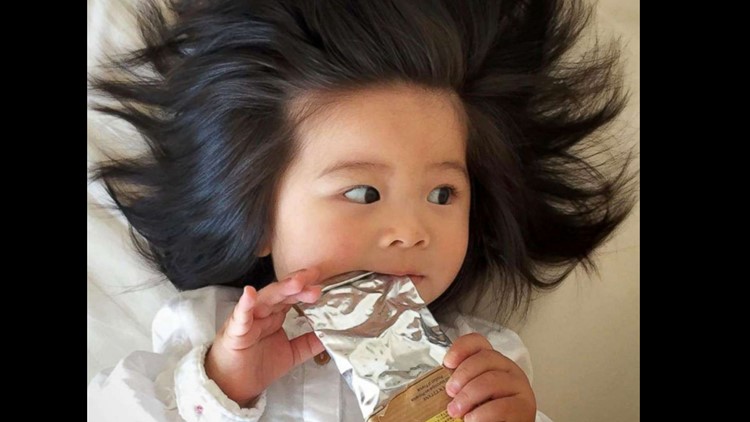(ABC News)--At just barely 13 months old, a baby in Japan has won over hearts around the nation and the world thanks to Instagram and her full head of luxurious locks.
Baby Chanco is a pint-sized bundle of joy who was born in Kyoto, Japan, with a full head of hair.
When she was just four months old, Chanco's mom Mami Kano posted a photo of her baby on Instagram in front of a bright yellow background with big brown eyes and thick dark hair standing on its ends.
The post garnered thousands of likes and spiraled into a social media sensation.
Now Baby Chanco has nearly 400,000 followers on Instagram and was recently named the new face of Pantene in Japan.
"We hope that she is gonna be involved in fashion ... particularly like [a] model, where she will be able to deliver attraction or charm of Japan or Japanese culture throughout the world," her mom told ABC News' "Nightline" through a translator.
Like any baby diva, Chanco has her fair share of fussy moments, but that didn't stop the multi-billion dollar adult hair care company from deciding to partner with an infant and disrupt Japanese beauty standards.
Yoshiaki Okura, a brand director for Pantene, said it was Baby Chanco's "unique" tresses that stunned them.
"When I saw Baby Chanco, I was really surprised. You know, I’ve honestly never seen such kind of baby to have such unique, thick hair," he said.
Her glorious mane has already made her the youngest person to ever model for a global hair care brand.
"We thought Baby Chanco fits best to our brand campaign, which is '#HairWeGo,' because she is a great symbol of diversity, uniqueness," Okura said. "We felt it's [the] best fit for us."
The baby is part of a lucrative, sometimes controversial, and highly competitive world of child modeling.
Young children serve as brand ambassadors for household names like Ralph Lauren, Target and Macy's.
Mothers who manage their kids, also known as "momagers," have turned child models into major stars -- including celebrities like Raven Symone, Cara Delevingne and Gigi Hadid.
Denise Albert, a mother of two and co-founder of multi-platform brand The Moms, said she thinks babymodeling jobs "can be extremely lucrative."
"I think we live in a world right now where there are so many opportunities, and so many parents are business people. And they want side jobs," she said. "And they want to make money in other ways for their family, and if they can do that using social media, why not?"
Social media has quickly become the tool of choice for parents to garner attention for their children and get them out there.
Albert said she believes "Instagram and other social media platforms are a great way for modeling agencies to find new talent."
"It's a really easy way to see the personality of a child, to see the personality of a family and I think that it just makes searching a lot easier," she explained.
Modeling agent Brandis Ohlsson agreed.
"Instagram has changed things for the good and for the bad," she said.
"I think there are a lot of really great aspects to it," she said of social media's explosive growth in recent years. "It does help us find new talent every once in a while it's really great marketing tool. I would say that my business was basically built off social media."
Ohlsson and Elizabeth Petty are the force behind some of those child models and represent and photograph aspiring young talent.
In her experience, Ohlsson said casting directors don't necessarily care about a child's Instagram following. Rather, they are more interested in what they look like in their natural state.
Ohlsson said casting directors have only asked her about a child's Instagram "maybe three times," and only "once or twice" about follower count.
"Other than that they just want to see the kids candidly, it has nothing to do with the follower count," she said. "It's about, 'what does the kiddo look like when they're just being a kiddo?'" she explained.
Petty, who photographs child models, offered a piece of advice for parents trying to get a modeling gig through Instagram.
"On Instagram, always be aware that there's somebody -- if they have access to your photos -- they might be taking it the wrong way," she cautioned. "There's creepers out there who are attracted to kids, and it's just like the sad reality of life. And you should just kind of like be aware of what you're posting."
Kindergarten may be a day job for these children, but after school, a studio photo shoot is often their side hustle.
Petty said that one thing that makes a good child model "is that they want to be there."
"The best kid model is the one who's like 'Mommy, I want to be on TV'; 'Mommy how do how do I get in a magazine?' And then the mom is like 'OK, I'll look into it because they keep begging me,'" she said. "So they walk on set and they love being there. They light up in front of the camera. They're so happy to just be there and have fun with other kids."
But while "momagers" try to build a following on Instagram, Brandis said finding the next Baby Chanco is like catching lightning in a bottle.
"What you'll find now, I'm sure, in the next few months, there'll be babies popping up on Instagram with long hair thinking that, 'Well, my kid has got long hair too, that's the same thing that's going to happen.' And it just doesn't," Ohlsson said.
She continued, "Don't think you're going to be paying your mortgage with what your child makes."
"I would say take everything you hear and say with a grain of salt," she added.
Children's wear is a multi-billion dollar industry in the United States, and mothers have been a driving force behind the talent.
They handle their child's day-to-day schedules, balancing school and modeling gigs.
Many parents have worries that a child could grow up and not like that their photos are out there for the world to see.
Larissa, a mother of two child models -- Pax and Knox -- said she thinks about what her children may have to say about her decision in the future.
"I think about it all the time because you don’t know," Larissa, who preferred to use her first name only, said. "Maybe [modeling] won’t even exist anymore ... That’s what I keep thinking, I feel like everything is just going to go away."
Until then, the number of photos and amount of oversharing could leave them vulnerable to scams and dark corners of the internet.
Ohlsson said "we're all aware" of the "creepy side" of child modeling, "but there's also just things that are a little bit more innocent."
She cautioned that "pay-to-play" is a practice in the business where brands will say something like, "'We're doing a show for New York Fashion Week, [and] your kid has been chosen. We would love for them to participate. Can you pay me $3,000 for the dress that they'll wear?'"
"I think that when you're on social media and you're looking to become a model that way and somebody approaches you and you've not gone through the proper channels, I think you're more apt to fall prey to that kind of thing," she explained.



